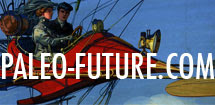Today we have two men that are either geniuses or completely crazy. While that fine line is usually difficult to discern in any worthwhile endeavor it is especially difficult in the context of futurism.

We begin with
Richard Buckminster Fuller (1895-1983), perhaps most famous for inventing the
geodesic dome. What may be most compelling about the man was his fascination with documenting his own life. Stanford University Libraries acquired Fuller's archives in 1999. In what is called the
Dymaxion Chronofile, Fuller was obsessive about documenting everything that happened to him.
Started in 1917, the Chronofile was "a massive scrapbook that included copies of all his incoming and outgoing correspondence, newspaper clippings, notes and sketches and even dry cleaning bills." Fuller continued the Chronofile until his death in 1983 at which time he had created/accumulated 270 linear feet of documentation.
Our next madman/genius does not measure his life in linear feet, but rather gigabytes. 72-year old Microsoft researcher
Gordon Bell uses the custom-designed software
MyLifeBits to document every piece of his life. He has a camera that hangs from his neck which takes a picture every 60 seconds, a scanner which digitizes all his paper documents, a modified phone tap for phone calls, and a digital audio recorder for constant everyday conversational recording.

The November, 2006 issue of Fast Company even had him on the cover and did a pretty incredible piece on
his crazy endeavor. At the end of the day I tend to side with skeptics in the article that argue, "forgetting is how we make sense of life."
There needs to be some kind of balance. I value my photographs above all my other possessions on earth. It scares me that a single fire could wipe out all of my negatives from 1998-2002 and a couple hard drive malfunctions could erase all of my digital photos I haven't stored on
Flickr. The fragility of memory makes these things valuable to me. If I had a massive database that cataloged every image I saw in 60 second intervals I would probably lose attatchment to the images that document my life on a far less frequent basis.
Where does that leave the lives of others and the documents we cherish? I value the single photograph I have of my great-great grandparents from Slovenia but I would love to see what their day-to-day lives were like. Again, I truly believe balance is the key. Balanced or not, Fuller and Bell may give us a sneak peek into the future of memory.
-Matt
If you're looking for more information on Buckminster Fuller:
To my amazement, Stanford University has an
audio-visual collection online about Fuller as well. You will have to register (for free) but I would suggest checking it out if you get a chance.
 "Even though scientists think Martian conditions are severe, they believe that if man journeyed to Mars he could survive here with moderate protection... life [on Mars] could be almost normal inside pressurized houses and pressurized cities."
"Even though scientists think Martian conditions are severe, they believe that if man journeyed to Mars he could survive here with moderate protection... life [on Mars] could be almost normal inside pressurized houses and pressurized cities." "Today, as we face the problems of over-population and depletion of natural resources the possibility of Mars becoming a new frontier is of increasing importance in our plans for the future."
"Today, as we face the problems of over-population and depletion of natural resources the possibility of Mars becoming a new frontier is of increasing importance in our plans for the future." You can view a clip of the program here and you can find this program in its entirety on the DVD set Walt Disney Treasures - Tomorrowland: Disney in Space and Beyond. The program originally aired on December 4, 1957 and was eventually released theatrically.
You can view a clip of the program here and you can find this program in its entirety on the DVD set Walt Disney Treasures - Tomorrowland: Disney in Space and Beyond. The program originally aired on December 4, 1957 and was eventually released theatrically.













































